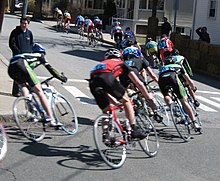A criterium, or crit, is a bike race held on a short course (usually less than 1 mile), often run on closed-off city centre streets.
Collegiate cyclists take a tight downhill corner in the Boston Beanpot Criterium at Tufts University
Race length can be determined by a number of laps or total time, in which case the number of remaining laps is calculated as the race progresses. The winner is the first rider to cross the finish line without having been “lapped.”
Events often have prizes (called primes, pronounced “preems”, and are usually cash ( or Easter eggs this week at Linton) for winning specific intermediate laps (for instance, every 10th lap). A bell ( in our case a whistle”) is usually rung to announce to the riders that whoever wins the next lap, wins the prime.
Success in road criteriums requires a mix of good technical skills — in particular, the ability to corner smoothly while “holding your line” on the road, as well as rapidly and sharply — and riding safely with a large group on a short circuit and exceptional “sprint” ability to attack other riders and repeatedly accelerate hard from corners.
And for anyone who has been out to Linton over the past 2 weeks when we have run Points races you will after reading the above realise what the difference is.
In a points race you race for points on “the Whistle” . The person with the most points at the end of the race is the winner. Points are accumulated during the race on whistle laps. Duration of the race is a set time plus 1 or 2 laps.
